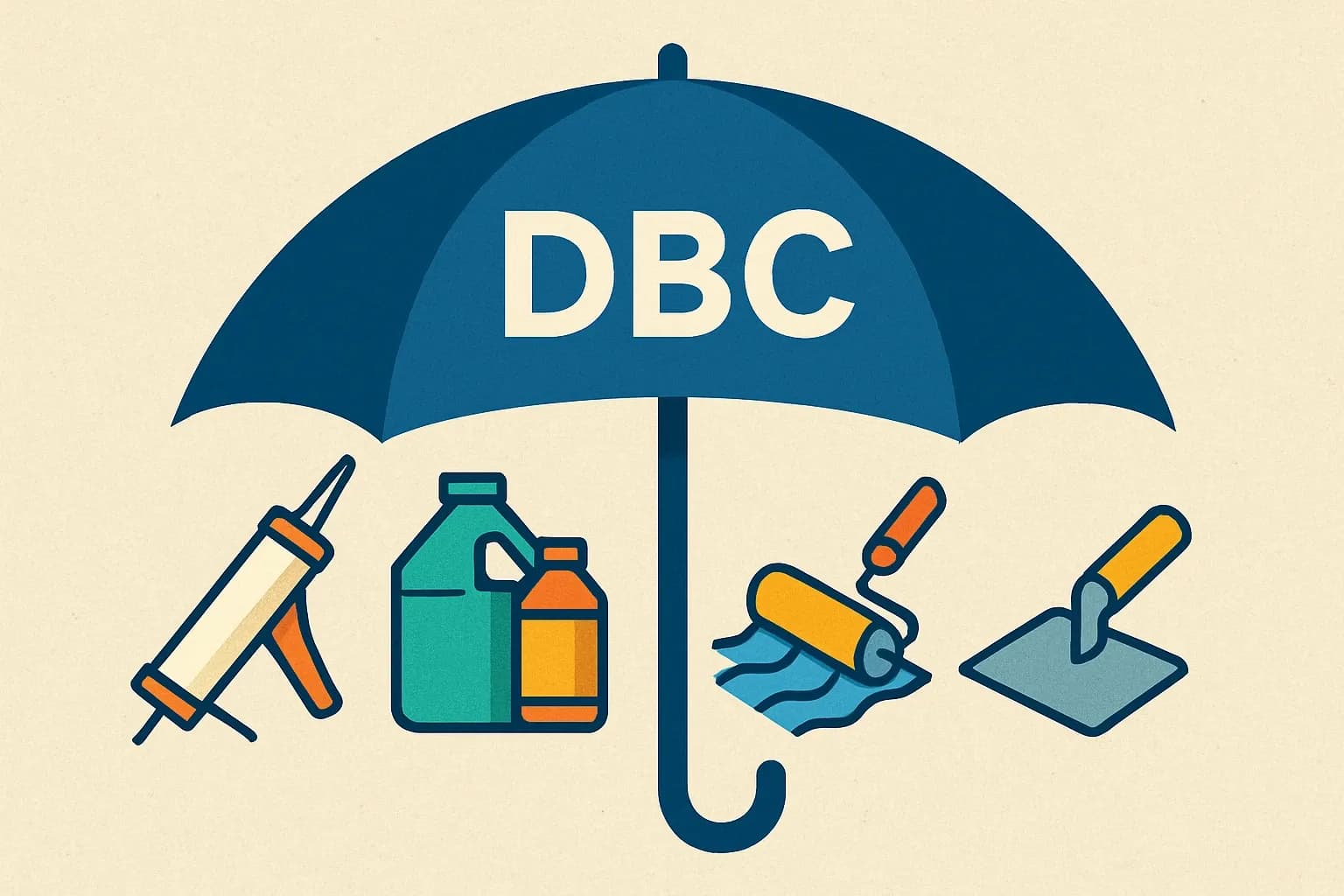DBC (Deutsche Bauchemie) and EPDs, clarified
Confused by DBC and product EPDs? Quick reality check. dbc-online.de points to Deutsche Bauchemie e.V., the German construction chemicals association, not a manufacturer. They do not sell products. Their members do and the portfolio is broad. Here is how that map looks and how well it is currently covered by EPDs, plus where the spec wins are hiding for teams that move first.


Who DBC actually is
DBC here means Deutsche Bauchemie e.V., the umbrella association for Germany’s construction chemicals industry. About 140 companies are organized in the association, accounting for roughly half of Europe’s market volume and about a quarter of the global market (Deutsche Bauchemie, 2025) (Deutsche Bauchemie, 2025). If you were thinking of DBV, the concrete engineering association, that is a different org.
What “products” sit under the DBC umbrella
DBC itself sells none. Its members span eight major families that show up on nearly every project:
- Concrete and mortar admixtures
- Concrete repair and surface protection
- Reaction resin coatings and flooring
- Liquid‑applied waterproofing systems
- Cold processed bitumen products
- Construction sealants and adhesives
- Modified mineral mortars and grouts
- Wood preservatives
For sustainability resources tailored to these families, DBC hosts a Model EPD portal that members can use to accelerate product declarations. See the Muster‑EPDs and guidance on the association site: DBC Model EPD portal.
How well these categories are covered by EPDs today
Coverage is uneven but improving. Germany’s IBU alone reported 4,700 total EPDs at the end of 2024, including 533 new EPDs and more than 300 digital EPDs that year, a strong signal for chemicals-heavy categories like sealants, membranes, and resin floors (IBU, 2024) (IBU, 2024). At the European level, program operators continue to expand digital-ready formats, which makes spec verification faster.
Where gaps usually live
Three pockets often lag. General‑purpose silicones and hybrid sealants that sell in high volume. Cementitious grouts and repair mortars with many regional variants. Primers and accessory chemistries that teams treat as “small stuff.” Those lines are frequently in the tens to hundreds of SKUs per brand, yet they still lack product‑specific EPDs in many ranges.
DBC’s Model EPDs can shorten the on‑ramp
DBC provides European Model EPDs and member‑only EPD guides that define scope and data ranges for families like polyurethane or silane‑modified products. Manufacturers can adapt these to product‑specific EPDs with the right primary data and QA, then publish with operators such as IBU or EPD International. That path cuts calendar time and reduces back‑and‑forth during review.
The spec math that moves budgets
LEED v4.1 awards credit when a project team uses at least 20 different permanently installed products from five manufacturers that meet EPD criteria. Product‑specific Type III EPDs count as 1.5 products, which can tip a project over the line when schedules are tight (USGBC, 2024) (USGBC, 2024). When your product lacks an EPD, project teams often default to conservative impact values. That creates friction and makes price the only lever.
Likely competitors you meet in bids
In DBC member categories, the names repeat across healthcare, offices, education, and industrial builds. Sika. Mapei. Master Builders Solutions. Tremco CPG. Saint‑Gobain Weber. Bostik. Soudal. Illbruck. Ardex. Henkel. Many of their membranes, sealants, adhesives, and resin floors already carry EPDs in multiple markets. If your hero silicone, waterproofing slurry, or epoxy floor still lacks an EPD, you risk getting swapped for an EPD‑backed alternative during shortlist reviews.
Rough scale of portfolios and where to start
Typical brands in these segments manage dozens to hundreds of SKUs per category. Start with the top ten revenue drivers or the items most often requested by specifiers. Add one representative product per sub‑family to avoid holes that push teams to competitors mid‑project.
Picking the right rulebook and operator
Match the PCR used by the products you compete with so specifiers can compare apples to apples. Check expiry timing to avoid rework in the next cycle. Publish with a program operator that your sales regions already know. In Germany that is often IBU. In pan‑EU and global work, EPD International sees wide use.
Make data collection painless for your plant and R&D
Most delays happen inside the factory walls. Set a clear reference year, nominate a single point of contact for utilities, purchasing, and waste, and lock a short weekly check‑in. A partner who runs white‑glove data wrangling across sites is worth it, because your best people stay focused on production and product quality instead of chasing meters and invoices. There is few reasons to wait.
The takeaway for DBC‑aligned manufacturers
DBC is not a producer, yet it is a powerful catalyst. Use its Model EPDs to move faster, then turn your best sellers into enviromental declarations specifiers can trust. That combination wins more shortlists, keeps margin pressure down, and positions your portfolio for the next round of low‑carbon procurement.
Frequently Asked Questions
Is DBC a manufacturer and does it have its own EPDs?
No. Deutsche Bauchemie e.V. is an industry association. It does not sell products and therefore does not publish product EPDs. Its members manufacture the products and publish EPDs with program operators.
How many product families does DBC represent?
Eight broad families including admixtures, repair and protection, resin coatings and floors, liquid‑applied waterproofing, cold processed bitumen, sealants and adhesives, modified mineral mortars, and wood preservatives.
What is the quickest path to an EPD if we have none today?
Leverage DBC’s Model EPDs for the relevant chemistry, align your PCR choice with competitor practice, collect one year of primary data for a hero product, and publish through a recognized operator such as IBU or EPD International.
Which standards should our EPDs follow to contribute to LEED?
LEED v4.1 recognizes EPDs that conform to ISO 14025 and EN 15804 or ISO 21930 with at least cradle‑to‑gate scope. Product‑specific Type III EPDs count as 1.5 products toward the MR credit (USGBC, 2024).
